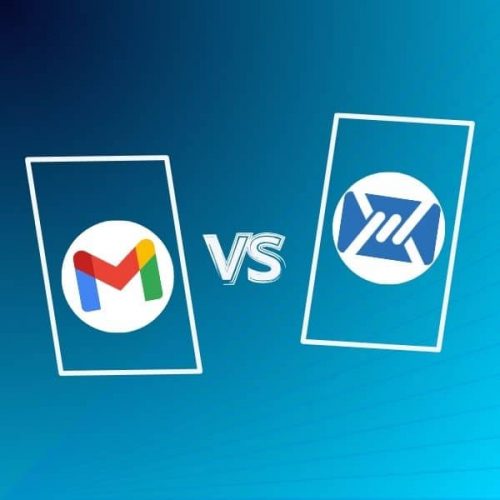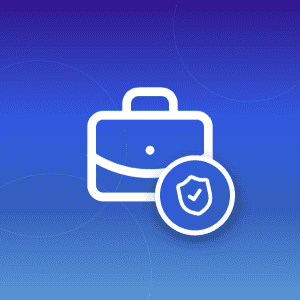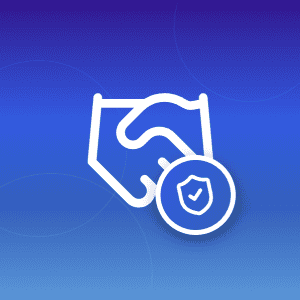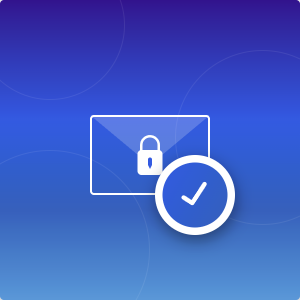In 2025, choosing between Gmail vs Mailfence goes beyond just emailing. It’s about control, privacy, and trust.
Gmail, from Google, dominates with advanced features, powerful AI tools, and so-called “zero cost”. Mailfence places privacy at the core: no ads, no tracking, and full encryption. Both have their pros and cons, but this guide will help you make an educated choice on the tradeoffs.
Get the latest privacy news in your inbox
Sign up to the Mailfence Newsletter.
About Gmail and Mailfence
Gmail and Mailfence represent opposite ends of the email service spectrum. As the world’s most popular email provider, Gmail is deeply integrated into the Google ecosystem, while Mailfence is a privacy-focused alternative based in Europe.
Gmail is operated by Google, a U.S.-based Big Tech giant whose business model depends heavily on data-driven services and advertising. While Gmail claims it no longer uses email content for ad targeting, it still processes messages to fuel features like Smart Compose, categorization, and malware scanning and has a business model based on ‘data monetization’. Its seamless integration with Google Docs, Drive, and Meet makes it a powerful choice for productivity, but any privacy-focused person should be concerned by Google’s track record.
Mailfence is an independent email provider located in Belgium, where user data is protected under strict EU privacy laws. The company is not owned by any foreign corporation and cannot be compelled by U.S. gag orders or National Security Letters. Only a lawful Belgian court order can require data access. Mailfence combines encrypted email, calendar, contacts, and cloud storage in one secure platform, built to protect your freedom rather than monetize your behavior.
Gmail vs Mailfence: Pricing Comparison
Understanding how each provider structures its pricing reveals a lot about their priorities and values.
Both Gmail and Mailfence offer free plans, but each comes with trade-offs.
Gmail’s “free” model is funded by your data, powering Google’s broader ecosystem and AI tools. Mailfence, on the other hand, offers a free plan with limited storage, but without any data mining or ad targeting.
Mailfence’s first paid plan, the Base plan, starts at just 2.50 € per month. For 3.50 € per month, the Entry plan offers expanded storage, support for custom domains, email aliases, and group collaboration features.
Gmail’s paid plans are grouped under the “Google One” umbrella. They begin with the Basic plan at 1.99€/month for additional storage. For more robust features like custom domains, shared drives, and admin tools, you’ll need to migrate to their Business plans, labelled under “Google Workspace”.
Mailfence vs Google One
Google One is Google’s group offering of Gmail, AI (Gemini), Drive, Photos, Meet, and more.
| Mailfence | Price | Google One | Price |
|---|---|---|---|
| Free | 0 € / month | Free | 0 € / month |
| Base | 2.50 € / month | Basic | 1.99 € / month |
| Entry | 3.50 € / month | Premium | 2.99 € / month |
| Pro | 9.50 € / month | AI Pro | 5.20 € / month |
| Ultra | 29 € / month |
While prices might look similar, it’s important to remember this is not an apples-to-apples comparison:
- Google One’s paid plans do not offer basic features such as email aliases, custom domains, and multiple users.
- Google One is meant for individuals; there is no way to create and manage additional users.
- All of Google’s products are grouped together, so you will be paying for them whether you use them or not.
Mailfence vs Google Workspace
Workspace is Google’s business offering, featuring per-user plans.
In this model, Google forces all users in a workspace to take the same plan:
- Business Starter (3.5€/month/user)
- Business Standard (7€/month/user)
- Business Plus (14.67€/month/user)
Let’s say your team of 10 people is on the Business Starter plan. If even just one person needs more storage and wants to move to the Business Standard plan, everything needs to be upgraded. This would represent a 35€/month increase.
On the contrary, Mailfence is structured so that each user can pick the plan most adapted to his or her needs. When a user becomes an admin (by taking an Entry plan or higher), they can create and manage a given number of users, each with their own subscription plan.
Here’s a breakdown:
| Mailfence | # users managed |
|---|---|
| Entry (3.5€/month) | 2 free users + 2 paid users* |
| Pro (9.5€/month) | 10 free users + 190 paid users* |
| Ultra (29€/month) | 10 free users + 990 paid users* |
*paid users can be either Base, Entry, Pro, or Ultra)
For a family or an organization of any size, Mailfence is a much more affordable solution. It is also a much more flexible solution, allowing each user to have their own subscription plan.
Gmail vs Mailfence: Security & Privacy
Mailfence offers privacy by design, with privacy tools built into its very core:
- end-to-end encryption for emails;
- encryption at rest;
- digital signatures;
- no third-party advertising or marketing trackers;
- your data stays safe on European servers located in Belgium, under strong GDPR protection.
On the other hand, Gmail is the perfect example of surveillance capitalism at work.
AI tools like Smart Compose seem powerful on the surface. But they rely on analyzing user data. Gmail scans the content of each of your emails. They say they don’t use the data they collect for targeted ads, but you will have to take their word for it.
While Google complies with global regulations, it’s built on monetizing user data. Your emails, behavior, and metadata fuel predictions and insights.
Additionally, Gmail does not offer native OpenPGP support built‑in. You can’t just enable it in settings; there’s no direct way to send fully end‑to‑end encrypted PGP emails using Gmail alone.
Gmail vs Mailfence: Features & Productivity
There is no doubt that Gmail offers one of the most extensive, feature-rich ecosystems. Gmail, Google Docs, Google Meet, Google Calendar, Google Maps, Google Photos… AI features are plentiful, such as Smart Compose, AI-generated summaries, language translation, and more.
However, as already explained, all of this comes at a cost: your data and privacy.
On the other hand, Mailfence offers a truly private experience without compromising on features, both for personal and professional use.
Email Comparison
| Feature | Mailfence | Gmail |
|---|---|---|
| Aliases | ✅ | 🟨 (requires a custom domain) |
| Password-encrypted emails | ✅ | ❌ |
| OpenPGP-encrypted emails | ✅ | ❌ |
| OpenPGP digital signatures | ✅ | ❌ |
| Custom domains | ✅ | ✅ |
| Ad- and data monetization-free | ✅ | ❌ |
Calendar Comparison
| Feature | Mailfence | Google Calendar |
|---|---|---|
| Multiple individual Calendars | ❌ | ✅ |
| Group Calendar | ✅ | ✅ |
| CalDAV support | ✅ | ❌ |
| Event tags | ✅ | ❌ |
| Public access to Calendar | ✅ | ✅ |
| SMS Calendar Reminders | ✅ | ❌ |
| Polls (Doodle-like) | ✅ | ❌ |
| Push notifications | ❌ | ✅ |
Online Storage comparison
| Feature | Mailfence | Google Drive |
|---|---|---|
| Group Documents | ✅ | ❌ (shared folders, but no “group” concept) |
| WebDAV Access | ✅ | ❌ (requires 3rd-party bridge) |
| File Link Sharing | ✅ | ✅ |
| Public Sharing | ✅ | ✅ |
| Versioning | ❌ | ✅ |
| WebDAV/SMB Client | ✅ | ❌ |
| Tags | ✅ | ✅ |
Contacts comparison
| Feature | Mailfence | Google Contacts |
|---|---|---|
| Group Contacts | ✅ | ✅ |
| CardDAV Syncronisation | ✅ | ✅ |
| Tags | ✅ | ❌ |
| Comments | ✅ | ❌ |
Gmail vs Mailfence: Ease of Use & Interface
Mailfence offers a clean, traditional email layout that’s intuitive and easy to pick up, especially for users familiar with standard email clients. In a world of digital overload, Mailfence focuses on simplicity and minimalism, avoiding clutter, push notifications, and any other unnecessary distractions.
The interface is deliberately minimalist; everything you need is there, but nothing that compromises usability or privacy.
Gmail, on the other hand, delivers a polished, modern interface backed by years of user feedback and design refinement.
As part of a multi-trillion-dollar tech company, Google has the resources to fine-tune every pixel.
The result is a highly responsive platform with powerful features like conversation threading, labels, and predictive search. However, this same feature richness can make Gmail feel overwhelming to users who just want a straightforward email experience.
Ultimately, both services are user-friendly, but in different ways. Gmail offers advanced tools and a fluid design experience that billions are already used to. Mailfence opts for clarity and focus, offering all essential functions without the distraction of over engineering. Which you prefer depends on whether you value a minimalist vs a feature-rich experience.
Gmail vs Mailfence: Final Words
Choosing between Gmail and Mailfence isn’t just a technical decision. It’s a choice between two fundamentally different philosophies.
Gmail offers seamless integration, powerful AI features, and convenience at scale. But that convenience is built on a business model that monetizes your data. Even if you trust Google’s intentions, you’re still contributing to a system that treats personal information as a product.
Mailfence, in contrast, is built from the ground up to respect user privacy.
It delivers strong encryption, secure document and contact management, and a user-focused ecosystem that doesn’t rely on advertising or surveillance. Your data stays in Belgium, protected by some of the strongest privacy laws in the world.
Gmail may win on polish and range of features, but Mailfence wins on ethics, privacy, and long-term trust.
Ready to take your online privacy to the next level? Create your free Mailfence account today!
Get the latest privacy news in your inbox
Sign up to the Mailfence Newsletter.



